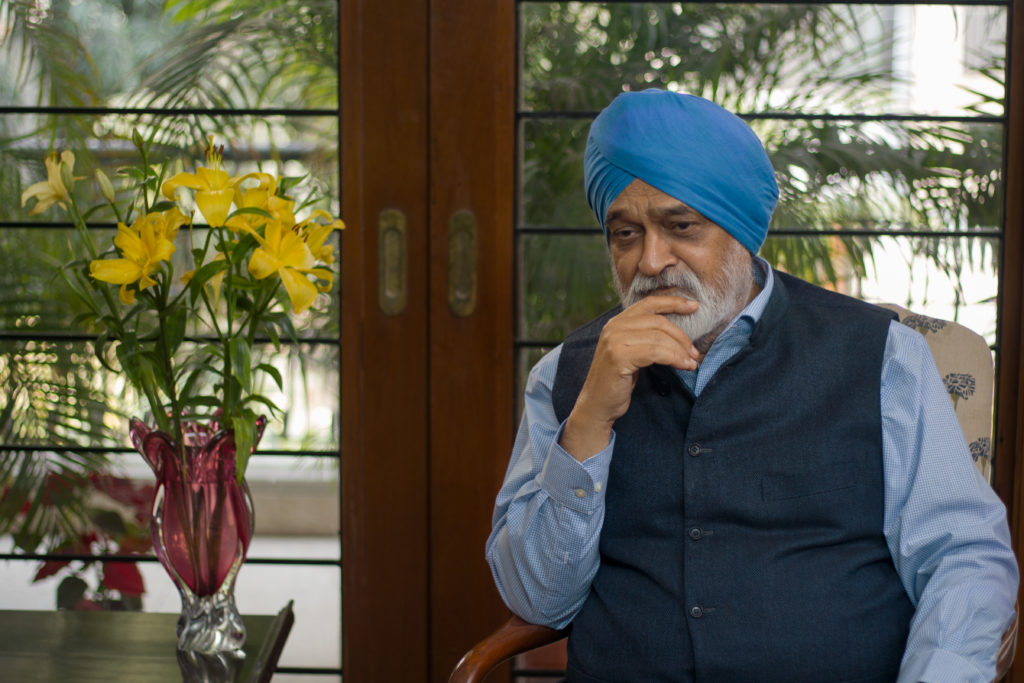Montek Singh Ahluwalia will be in conversation with Parakala Prabhakar during HLF 2021 session on his latest book – Backstage: The Story Behind India’s High Growth Years on January 24, at 5 pm
Montek Singh Ahluwalia played a key role as an economist for three decades and an important influence on the Indian economic policy. While giving an insider view of state of affairs and the impact on the growth of India and transformation of the nation, Montek Singh Ahluwalia’s insights also help decode the present day issues that face Indian economy.
Here’s a portion from his latest book that gives an overview of NDA years and the affects of financial reforms, especially implementation of demonitization and GST.
Extract sourced from Rupa Publications website
The economic performance of the first six years of the NDA government can be described as ‘beginning with a bang and ending with a whimper’. The electorate wanted a quick return to high growth, and Finance Minister Arun Jaitley, while presenting the Budget for 2015–16, played to this expectation by declaring ‘Aiming for double-digit growth seems feasible very soon.’
The policies that would be adopted to achieve this objective were not specified, but there were some signals. The slogan ‘Minimum Government Maximum Governance’ suggested continuity in liberalizing the economy. The new government also signalled a commitment to fiscal prudence when Finance Minister Jaitley, presenting his first Budget in July 2014, said he was retaining the fiscal deficit target of 4.1 per cent of GDP set by his predecessor in the interim Budget, and promised to reduce it to 3 per cent by 2016–17. Policy signals on FDI were also broadly positive. PM Modi presented his ‘Make in India’ initiative as an invitation to foreign investors to set up production facilities. This was a politically important signal because parts of the Sangh Parivar were known to be anti-FDI.
The new government was also careful to avoid seeming ‘anti-poor’. Programmes such as MGNREGA, which were earlier criticized as wasteful, were continued and even expanded. Some existing programmes were rebranded and given a higher political profile. For example, the Total Sanitation Programme, which provided toilets to reduce open defecation in rural areas, was rebranded as ‘Swachh Bharat’ and PM Modi, in his first Independence Day address, announced a target of making India ‘open defecation free’ by 2 October 2019, the 150th birth anniversary of Mahatma Gandhi. Similarly, the UPA programme of opening ‘no-frills bank accounts’ for the poor, combined with direct transfer of certain benefits into these accounts, all assisted by the Aadhaar (the Unique Identity Scheme of the UPA) and mobile connectivity, was repackaged and given the catchy title of ‘the JAM trinity’. The National e-Governance Plan was repackaged as ‘Digital India’. The Rashtriya Krishi Vikas Yojana was repackaged as ‘Paramparagat Krishi Vikas Yojana’.
Economic performance under the NDA improved initially but the improvement was short-lived. A new national accounts series was introduced in 2015. According to this series, growth peaked at 8 per cent in 2015–16, using the GVA measure which corresponds to GDP at factor cost used earlier, and then decelerated steadily, falling to 4.5 per cent in the second quarter of 2019–20. The Advance Estimates, released by the National Statistical Office in January 2020, projected growth for the year as a whole at 4.9 per cent. This implies that the NDA government in its first six years, would have delivered an average growth rate of only 6.9 per cent, compared to an average of 7.8 per cent for the 10 years of the UPA.
Part of the revival of growth in the first three years was simply a continuation of the upturn that had begun in the last year of the UPA, when growth moved up to 6.1 per cent in 2013–14. Performance in the first two years of the NDA was greatly helped by the collapse in world oil prices in October 2014, which created a very favourable external environment compared to the situation facing the UPA when oil prices were very high. However, questions began to be raised about whether the new national accounts series was overestimating growth. Data on sales of trucks, cars, scooters, consumer electronics, etc., as well as the growth of bank credit, suggested that economic growth was much slower than indicated by the new series. Businessmen began to say in private that ‘it did not feel like the economy was growing at 7 per cent’.
The issue of whether the new series was overestimating growth was examined by Arvind Subramanian, who was the chief economic advisor in the Ministry of Finance in the first three years of the NDA government, and then moved to Harvard in 2017. He found that the growth rate using the new series for the period from 2011–12 to 2015–16 was much less correlated with growth in many economic variables with which growth in the earlier series was more closely correlated. Probing deeper, he concluded that the new series may be overestimating the annual GDP growth rate over this period by 2.5 percentage points.
Data on employment from the Periodic Labour Force Surve (PLFS) for 2017–18 also cast doubt on the growth narrative. Employment had been a weak spot even in the UPA years, but there was no increase in the rate of unemployment in that period. The problem was that the quality of jobs generated was poor, with new employment being largely of the non-formal type. The PLFS for 2017–18 showed a much worse situation with total employment falling from 474.2 million in 2011–12 to 465.1 million in 2017–18, and the rate of unemployment rising from 2.2 per cent in 2011–12 to 6.1 per cent in 2017–18.
The report on the PLFS was cleared by the National Statistical Commission (NSC) in November 2018 but its release was delayed until after the general election in May 2019. The chairman and one of the members of the NSC resigned over the interference with the release of the report. Government spokesmen dismissed the results of the PLFS, citing other partial data to suggest that employment had increased. However, independent surveys by the Centre for Monitoring Indian Economy (CMIE) confirmed that unemployment rates had increased and continued to do so even after 2017–18. The CMIE estimate for unemployment for the month of October 2019 was 8.5 per cent.
The NSSO household consumption survey for 2017–18 brought further bad news. The Business Standard, got hold of the results and reported that per capita consumption in 2017–18 was about 3.7 per cent lower in real terms than in 2011–12. NSSO surveys had traditionally shown lower consumption than the national accounts, but this was the first time since 1972 that the survey showed per capita consumption to be lower than in the previous survey (2011– 12). The government announced that the 2017–18 survey was being junked on the grounds that the results were not ‘in line’ with other information and a new survey would be carried out in 2021. This decision clearly compromised the independence of the statistical system. Over 200 prominent economists issued a statement on 21 November 2019 protesting the government’s decision.
Analysts working on the leaked data have shown that the decline in per capita consumption is primarily a reflection of adverse developments in rural areas. Real consumption has declined in all deciles in rural areas while all deciles in urban areas show an increase. The urban-rural divide has therefore widened. The percentage of the population in poverty has increased from 21.9 per cent in 2011–12 to 22.8 per cent in 2017–18. This increase in total poverty reflects a sharp increase in rural poverty swamping a decline in urban poverty.
The results of the household consumption survey highlight the poor performance in agriculture. The growth rate of agriculture and allied sectors had increased to 4.3 per cent in UPA 2, but it declined to an average of 2.9 per cent in the first five years of the NDA. Rural wages grew at about 6 per cent per year before 2013–14, but stagnated thereafter. Poor agricultural performance has contributed to agricultural distress and lack of demand in rural areas. This is one of the major factors contributing to the deceleration in overall growth in the economy.
Many had hoped that the installation of a government with a strong majority in the Lok Sabha and a declared objective of improving the ease of doing business would reassure investors and revive private investment. This did not happen. Gross fixed capital formation under the UPA had reached a peak of 32.9 per cent of GDP in 2007–08. It declined in 2008–09, the year of the global crisis, but recovered in the later years of UPA 2 to reach 31.3 per cent of GDP in 2013–14. Despite pro-investor statements by the NDA government, the rate of fixed investment declined in the NDA period to reach 28.1 per cent in 2019–20 according to the Advance Estimates.
Investment behaviour is driven by a complex combination of domestic and global factors. There were many domestic factors at work which depressed investment. The failure to meet fiscal targets and the uncertainty that it created about macroeconomic prospects was one factor. The Centre’s fiscal deficit for 2016–17 ended up at 3.5 per cent of GDP, half a percentage point higher than the finance minister had promised. More disturbingly, the Comptroller and Auditor General (CAG), in a report on the Centre’s fiscal performance for 2016–17, pointed out that the fiscal deficit for that year was understated by as much as 2 percentage points of GDP because of off-budget financing. This infirmity also affects the deficit numbers for subsequent years.
The failure to address the twin balance sheet problem, i.e. corporate balance sheets burdened with too much debt and bank balance sheets burdened with large NPAs, also contributed to the low growth in investment. As corporate managements shifted their attention to mending their balance sheets, they began to focus on reducing outstanding debt rather than investing and expanding capacity. This should have been an opportunity for those with better balance sheets, including mid-size companies, to expand but public sector banks saddled with large NPAs became highly risk averse and bank credit growth slowed down. Reduced growth in bank lending was initially offset by a growth in credit from non-banking financial companies (NBFCs), but these too soon came under stress with ILFS, one of the most prominent NBFCs, collapsing in 2017. The twin balance sheet problem was known in 2015 but was not addressed as quickly as it should have been.
Rahul Bajaj, speaking on the occasion of the 2019 Economic Times Awards function in Mumbai, drew attention to another problem that may have dampened animal spirits and that was the perception that the government was unwilling to hear any criticism. ‘During UPA 2,’ he said, ‘we could abuse anyone… But if we want to openly criticize you, there is no confidence you will appreciate that.’ Bajaj was clearly implying that business leaders were hesitant to talk about their problems which also meant that the problems were left unattended. He also talked about an ‘atmosphere of fear’. This was probably a reference to the fact that businessmen are highly vulnerable to investigations on tax evasion and alleged violations of the Foreign Exchange Management Act. Once action against an alleged violation is initiated, it triggers a very protracted legal process involving both economic costs and reputation loss.
Some part of the slowdown in the later years of the NDA can also be traced to two major policy mistakes—the demonetization of November 2016 and the manner in which the GST was implemented in 2017.
Demonetization came as a complete surprise when the government on 8 November 2016 announced that all currency notes of denominations `1,000 and `500, accounting for 86 per cent of the value of currency with the public, were no longer legal tender. Holders of these notes were given up to 31 December to take the notes to banks to convert them into new notes. The decision was originally presented as a decisive attack on black money and corruption, but as that particular justification seemed difficult to sustain, several other justifications were advanced.
[…] Eight months later, the economy received a second jolt when the GST was introduced in July 2017. Unlike demonetization, which had very little support from professional economists, the GST was universally regarded as a major reform of the indirect tax system. It was expected to generate larger revenues, and also simplify the system but it failed on both counts because of a flawed design and poor implementation.
















